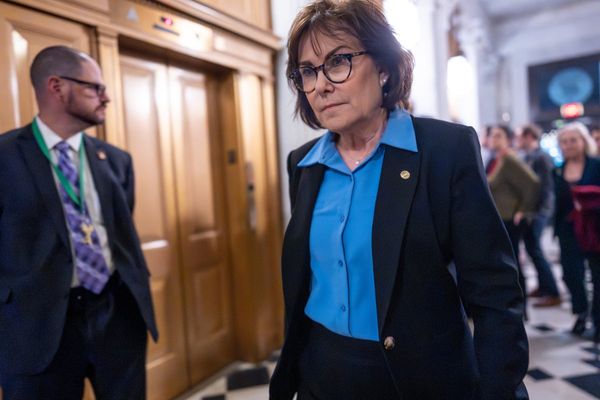
Director Dan Farah grew up with aliens. As a child of the 80s and 90s, pop culture was awash with extra-terrestrial sightings. “How can you be a kid watching movies like ET and Close Encounters, TV shows like The X Files, and not end up curious about whether or not we’re alone in the universe?” he said in an interview with the Guardian. “And whether or not the US government does, in fact, hold secrets from the public.”
Farah’s exposure to otherworldly beings in fiction kickstarted an interest that’s now morphed into a professional quest, and the subject of his documentary debut The Age of Disclosure. Here, Farah makes the case that the United States has been hiding, for decades, a font of information related to UAP (unidentified anomalous phenomena) – the acronym rebrand of the stigma-ridden UFO.
It would be easy to assume this is the stuff of tin-foil hats and Reddit forums, and in some ways the documentary’s pseudo-narrator, Luis Elizondo, could come across as a type of conspiracy theorist at first glance. He’s armed with a blackboard and piece of chalk, working to sell the viewer, running through a lot of overwhelming military and intelligence jargon, like “hypersonic velocity” and “trans medium travel” with undeniable passion.
But there’s a reason why Farah gravitated towards Elizondo (who also serves as an executive producer on the film). He’s got genuine credentials. A former Pentagon official, who helped lead the Advanced Aerospace Threat Identification Program (AATIP), Elizondo eventually left his role in 2017, claiming the department was hiding vital information from the public. He also claims there was a “powerful disinformation campaign” from the Department of Defense to discredit his work.
Making a point to “only interview people who have direct knowledge” of these programs from working within the US government was a north star for Farah – who has served as a producer on several films, including Steven Spielberg’s Ready Player One. While filming The Age of Disclosure, as more former officials and experts got on board, it helped to convince others to take part.
But Farah ran a tight ship over the three years it took to make the film. “Everyone’s names would be kept silent until it was done,” he said, noting that he only told documentary subjects about who had agreed to take part in order to make them comfortable. “We would make the movie in secrecy, so this information of who’s in it would not get out there until we were done with this film, and these people I was approaching would have safety in numbers.”
Farah also opted to make the film independently, unattached from a studio or streamer. “None of them would ever want to participate in a big commercial documentary,” Farah explained. “They would be afraid of it being sensationalized. They would be afraid of being intercut with someone who was not on their level, who would undermine them.”
His first big commitment came from Jay Stratton, one of the defense officials who started AATIP. He had an established career investigating UAP and non-human intelligence life on behalf of the government, and was responsible for briefing senior lawmakers in Congress and the White House. “I have seen with my own eyes non-human craft and non-human beings,” Stratton says plainly at the beginning of the film.
After Stratton agreed to “break his silence” it had tremendous “ripple effects” on the rest of the film, and convinced others to come forward. When the current secretary of state, Marco Rubio, agreed to take part, that escalated things. “Then next thing you know, general Jim Clapper was participating,” Farah said of the former director of national intelligence under Barack Obama, who sat for an interview.
The sheer wealth of contributions, 34 to be exact, from members of Congress across the political spectrum, as well as people with rich national security experience – many of whom might balk at the prospect of a cable news hit let-alone an independent documentary – certainly lends a veneer of credibility. Off the bat you’re confronted with a propulsive string score, and a supercut of former military and intelligence officials ensconced in armchairs. They all offer brief summaries of their CVs, spell out that we are not alone, and why the American public ought to know more about it.
“This [UAP] technology does stuff that we can’t do, and if we can’t figure out what it is or what it wants, or what it’s being used for,” says a former director of aviation security at the National Security Council. The former chief scientist for AATIP claims that those who are tasked with ensuring information about UAPs doesn’t leak “will use whatever tool they can find to try to convince people they shouldn’t come forward”. Meanwhile a former defense official notes that if we’re able to understand the technology that we’re observing, it opens the door to so many “potentially beneficial impacts, including clean energy”.
In many ways, Rubio offers one of the more convincing arguments. He says that much of the research and intelligence about UAPs is on a need-to-know basis, with incoming administrations being left out of the loop on the details. “But that begins to ramp out of control,” he notes, leading to a lack of transparency that might give US adversaries a head start by analyzing UAP technology. It’s a theory that sounds all the more convincing coming from the noted foreign policy hawk, who spent time in the senate spearheading a bipartisan effort to understand more about UAPs.
The geopolitical arms race to reverse engineer UAP technology is, what Farah came to see, one of the biggest reasons behind the alleged cover-up. “You can’t tell your friends without telling your enemies,” Farah says in our interview, reciting one of Stratton’s lines in the documentary. He traces a line from the debunked 1947 Roswell “alien crash retrieval” (generally considered the genesis of modern UAP conspiracies) to what he sees as the ongoing effort to withhold information – for fear of enemies getting wind of how much the US knows about extraterrestrial life.
“Put yourself in the shoes of US government and military officials in the 40s,” Farah said, explaining that, fresh off a second world war victory, the Truman administration couldn’t tell the American people that “we’re in another conflict that we can’t protect anyone from, because we don’t even know anything about it”.
He says this race escalated when the US found out that other countries, like Russia, were capturing and retrieving UAP technology. “Here we are now where the people who run our country are not aware of the facts,” he added. “Those people are supposed to be aware of significant information like this that has high stakes for us. And at a base level, the public deserves to know the truth about fundamental facts, like we’re not alone in the universe.”
In The Age of Disclosure, it’s clear that there is little room for pushback or skepticism, particularly since there’s not a single detractor in the film to serve as a foil to the plethora of resolute interviewees. And Farah, for his part, doesn’t see the need for those voices to cloud the documentary’s throughline. “I think when people watch this movie, one of the realizations will be that the stigma around this topic is completely illogical and makes no sense and is not good for humanity,” he said. “We need the scientific community, not only in the United States, but in every nation, accepting the fact that this is a real situation, this is a valid area of inquiry, and that they should put their brain power towards learning about this and answering a lot of the big questions that remain.”
Testimony is ultimately what film hinges on, and it’s really the only “proof” it can offer. This, for Farah, is more compelling. He believes that “the strongest evidence” is “credible people putting their name and reputation on the line to tell you what they know at great risk”. When it comes to video and photos, the director notes that it would do little to quieten claims that it’s all a hoax. “You could put a picture or a video of the most extraordinary thing on the cover of a major news publication or on major plants on TV, and half the human population would tell you they think it’s AI or they think it’s visual effects,” he said.
As more people, like Elizondo and Stratton, speak out about their experiences, Farah hopes it will encourage more people who have been silenced in the past to attempt to reveal the truth. “For way too long, the public has been lied to, kept in the dark, completely misled by a heavily financed and very sophisticated disinformation campaign,” Farah said.
“I think it is only a matter of time before a sitting US president steps to the podium, and tells the world that we are not the only intelligent life in the universe, and that the United States government intends to lead in this new chapter by ending the era of secrecy and beginning the era of transparency.”
The Age of Disclosure is out now in the US with a UK date to be announced







